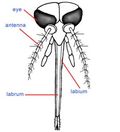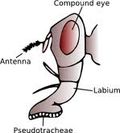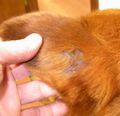 I posted on fly-bite dermatitis two years ago, as part of a longer post. What brought it back to mind was this dog. Since he has one ear up and erect, while the other is down and floppy, we have one dog who shows the typical sore places for both styles of ear.
I posted on fly-bite dermatitis two years ago, as part of a longer post. What brought it back to mind was this dog. Since he has one ear up and erect, while the other is down and floppy, we have one dog who shows the typical sore places for both styles of ear.
The mosquito causes a lot of problems for us, primarily heartworms in our area (malaria and other diseases in other countries). Their bites cause an allergic reaction that itches and swells, but it doesn't make a raw, sore place.
 The mosquito mouth parts resemble a hypodermic needle, which pretty much leaves a self-sealing puncture. We may have problems with the irritating saliva (or parasites)that are left behind, but the wound doesn't stay open and bleed and get infected.
The mosquito mouth parts resemble a hypodermic needle, which pretty much leaves a self-sealing puncture. We may have problems with the irritating saliva (or parasites)that are left behind, but the wound doesn't stay open and bleed and get infected.
 Flies don't have the needle-like proboscis of the mosquito. When they
Flies don't have the needle-like proboscis of the mosquito. When they
bite, it's more like a knife and a sponge. They make a little cut, then
sop up the blood that runs out. Get a few hundred tiny cuts, and
you've got a big sore on the dog's ear. This will generally be on the part of the dog's ear that is the highest elevation of the pinna (the floppy part).
 On a floppy-eared dog, it will
On a floppy-eared dog, it will
be the base of the ear like this guy's left ear.
 If the ear is erect (like a
If the ear is erect (like a
German Shepherd or Chow), the tips of the ears will be the damaged
area, like this guy's right ear.
Repelling the flies is the prevention and the cure. When the weather warms up, start putting insect repellent on the ears every day. I like VIP ointment, as it it is not messy. You can just put a transparently thin coating on the hair.
If you have let things get away from you and there is already an open sore, the dog won't leave the insect repellent on. The insect repellent burns if you get it in the sore place. Slop fly-dope all over the sore ear, and watch the dog run away and rub it off just as fast as he can.
You need to put a first-aid cream with local anesthetic (like
Neosporin Pain Relief, or a generic equivalent) on the spots FIRST. This numbs the area, plus provides a physical barrier between the sore place and the insect repellent. Then cover the area
with insect repellent, like VIP ointment. Don't put the insecticide in
the sore places – it burns and they won't leave it on.
Bad spots will need to be treated twice daily.


Wow. That’s a problem I’m so glad we don’t have. What is the context for so many flies? Farms?
Flies are certainly worse in the presence of livestock. However they breed in any type of organic material. This is a problem of outside dogs, usually dogs that are not moving around much. Either they are in small pens, or chained up, or it’s just too hot to move.
Some dogs just seem to be less bothered by the problem.
thanks for this info! Spot has a few bug bites-not on his ears-that I’ve put Benadryl cream on, it works great.
impressive post , thanks for sharing.
Have a GSD that I rescued and the tips of his ears are missing fur due to Fly bites…. Will that fur grow back and fill in?
Hello, Craig,
I doubt that the hair will return. It is often the case that the repeated trauma has caused the normal skin to be replaced by scar tissue. Before the flies begin to traumatize him again, I would go ahead and start using fly repellent ointment on them daily. They are more vulnerable to the fly trauma than a normal, haired skin would be.
In addition, using a flea control product that contains permethrin can also have some fly repellent effect. We use Vectra 3-D, but there are others. You want to use an approved product for dogs, not something like the permethrin spray that people use to treat their hunting clothes.
Thank you poor puppy 9nly has one chance to help the poor girl out ! having a difference of opinion and neither a vet so I suggest look up what to do before we reach a decision